
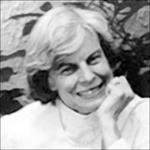
Time snaps by. It is has been two days from a year since Ann L. McLaughlin passed away. How I miss my brave, graceful, and very wise friend. Ann was a decade older than my mother but, curiously, that did not occur to me until she had passed: There was something ageless about her. She was a literary scholar and later, when I knew her, a writing teacher and an artist, a novelist of the most seriously dedicated and generous of our kind.
I met Ann in, I think it was 1999, when, having just moved to the area, I read from my short story collection at the Writer’s Center, in Bethesda MD, just outside Washington DC; as a founding faculty and board member, Ann did me the honor of so welcomingly introducing me to that audience. Shortly thereafter, thanks to a good word from poet and Gargoyle editor and publisher extraordinaire, Richard Peabody, I joined a writing critique group. A crackerjack writing group it was! At various points it included Kate Blackwell, Susan Coll, Kathleen Currie, Katharine Davis, Solveig Eggerz, E.J. Levy, Carolyn Parkhurst, Leslie Pietrzyk, Amy Stolls, Paula Whyman, and Mary Kay Zuravleff, among others– and always, always Ann.
When I joined the writing group, Ann was known for her loosely autobiographical novels Sunset at Rosalie, The Balancing Pole, and Lightning in July. Of the latter, set in Boston polio epidemic of the 1950s, Publisher’s Weekly lauds her “straightforward narration that transforms the events of a prolonged hospital stay into a richly textured tale.”
Novelist Andrew I. Dayton says it best:
“So deeply tragic. So tremendously sweet. Ann McLaughlin has captured humanity at its bravest. Artistic, accomplished Hally Blessing is stricken with polio in the prime of her youth, only weeks before the first polio vaccine. Within mere hours, Hally progreses from the elation of her first major venue as a young flautist to the despair of being diagnosed with polio. Ovecoming the deep challenges of fear and disfigurement, Hally struggles to find the inner resources which eventually enable her triumph. The scenes, the characters (even the minor characters) are all vividly portrayed. This work is a victory for the human spirit.”
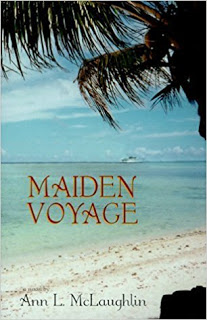
At that time, Ann was out and about promoting Maiden Voyage, a coming-of-age novel set in the 1920s on a newspaper magnate’s yacht. From Mimi Godfrey’s review in the Women’s National Book Association newsletter:
“McLaughlin is a clear-eyed and observant writer, and her evocation of 1920s Washington and the exotic ports of Julia’s trip– Madeira, Alexandria, Sicily, Greece, Zanzibar, Singapore, the South Pacific– is fascinating. But McLaughlin is more interested in charting Julia’s mind and heart, offering a kind of artist-novel of her development as a journalist and fledgling photographer. Julia wrestles with questions that were as vital today as they were in 1924: What is more important for a woman, a satisfying career or marriage and a family? Do the demands of a woman’s work matter as much as a man’s? Julia’s answers to these questions are, even more than the itinerary, what give this engaging novel its lasting satisfaction.”

For our writing group, Ann brought in draft after draft of chapters from The House on Q Street, her novel set in Washington during World War II. After The House on Q Street came A Trial in Summer, set in Depression-era San Francisco.
And although no longer in the writing group, for I’d returned to live in Mexico City, I had a chance to read drafts from Leaving Bayberry House and the proofs for Amy & George. I was honored to contribute a blurb for the latter, which takes the reader to 1930s Cambridge, Massachusetts:
“Once again, with charm and heart, McLaughlin brings to life a tumultuous period of U.S. history as she probes and delves into a father-daughter relationship that is sometimes a seesaw, sometimes a dance. This is a wise novel.”
Novelist Susan Richards Shreve adds her praise:

“George is dean of the Harvard Law School and Amy is his young, sensitive daughter. McLaughlin’s skill at portraying the quiet dangers of family life which culminate in an act of violence is tempered by a generosity of spirit and disarming honesty.”
As a member of her writing group I had a direct window into the effort it took to write these books. I was, and remain, in awe of Ann’s discipline. No matter what, and there were whats aplenty, Ann could sit herself down in the chair every day, fire up the laptop, and do the work. She had a truly rare dedication to craftsmanship, faith in her vision, and, at the same time, the willingness and sheer grit to rewrite, and rewrite again, and again, and again and, Lordy! as her characters often said, again.
And then whenever one of her books was published– this is especially hard for shy creatures such as writers, and no easy feat for one with health challenges– Ann would get herself out there, she sent the postcards, kept up with the torrents of emails, and with smiling aplomb, did the many rounds of readings and signings for her books. Her book signings at Washington DC’s Politics & Prose– one of the last and most prestigious of the great independent bookstores– were always packed, every chair taken, fans standing in the aisles.
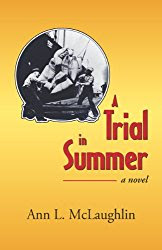
Among the many events for her novel A Trial in Summer was a party at my apartment. Somehow, my memory of that conflates with another party, for Mary Kay Zuravleff’s The Bowl is Already Broken, when Ann’s husband Charlie, an esteemed historian, was still alive. He was in a motorized scooter, but he had such joie de vivre, that scooter might have been a whim of a contraption for floating out of Oz. The picture I hold most vividly in my mind is of Charlie parked in the middle of that broad room, beaming, surrounded by so many, many of his and Ann’s adoring friends.
A few years after I had returned to live Mexico City, it seemed there might be a chance on the horizon to come back to DC and so, under the wing of Ann’s encouragement and endorsement, I joined the board of the Writer’s Center. That turned out to be a short-lived commitment on my part, alas, but what I remember so warmly– what magical moments!– was sitting at the table in her kitchen in Chevy Chase, petting her cat pretty Booska, while just the two of us talked writing and teaching writing and what we could do for that beloved literary oasis.
At the Writer’s Center Ann’s workshops were legendary. Novelist Frank S. Joseph told me, “Ann was the best writing instructor I ever had.”
Year after year Ann gave her students her all plus ten. I knew, from our many conversations, how much they meant to her. In most people’s minds “Washington DC” does not conjure images of literary community, but the fact is, the Writer’s Center is one of the largest literary centers in the United States, and the capital and surrounding area, deep into Maryland, Virginia and even Delaware, is filled with writers who, at some point, took one, two, or several of Ann’s workshops.
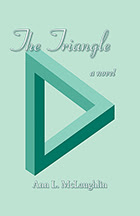
Even in her last months, her health failing, whilst in and out of hospitals, Ann kept on writing. She finished her ninth novel, The Triangle, and reviewed the page proofs. Her publisher, John Daniel, describes it thus:
“The Triangle returns to Boston’s 1955 polio epidemic, and combines the theme of coping with disability with that of struggle in the father-daughter friction and frustrated love. The author seems to have written the satisfying resolution to the two overlapping conflicts in her fictive life. This powerful novel is a satisfying finale of a brilliant career.”
Ann McLaughlin died at home on December 20, 2016.
I am but one of a multitude of people who can say that Ann enriched my life, both as a person and as an artist, immeasurably. Yet how fleeting the time I had with her, after all. Why did I not take one of her workshops? Why did I not ask Ann more about her friend and correspondent, John Updike, or about Janet Lewis, author of The Wife of Martin Guerre, whom she knew from her years in California? And I regret immensely that we did not talk more, in the most writerly vein, as we so easily might have, about the novels of Virginia Woolf, which she surely knew by heart, every one.
I will miss Ann for the rest of my life. Her novels, a treasure of a consolation, will always have a special place here by my desk in my writing room, and in my heart.
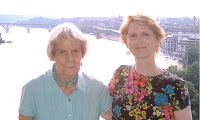
Photo by Alice J Mansell
Washington Post, January 1, 2017
ANN LANDIS McLAUGHLIN
Died at her home in Chevy Chase, MD on Tuesday, December 20, 2016 after a brief respiratory illness.
The daughter of James M. Landis and Stella McGehee Landis, she was born in 1928 and grew up in Cambridge, MA. She graduated from Radcliffe College in 1952 and received a PhD in literature from American University in 1978. Mrs. McLaughlin began teaching several courses every year at the Writers’ Center in Bethesda when it was founded in 1976 and continued teaching until the last year of her life; she also served on the board there. She had fellowships at the Virginia Center for the Creative Arts, Yaddo, and the Studios of Key West.
Ann was the author of eight novels, all published by John Daniel and Co., and recently finished correcting the final proofs on her ninth, to be published in 2017. Her readers were particularly drawn to her portraits of girls and young women coming of age, often in Depression-era America. She wrote with feeling of the intricacy of relationships those between sisters and particularly those between daughters and their difficult, if brilliant fathers. Her long and happy marriage to Charles C. McLaughlin, professor of history and editor of the Frederick Law Olmsted Papers, ended with his death in 2005.
She overcame many challenges, including polio, which she and her husband both contracted during the 1955 epidemic in Boston, which principally affected her speech and swallowing for the rest of her life. But her temperament was remarkably buoyant in the face of adversity and she will be remembered as one of the strongest and kindest of women. She will be missed by generations of students, her family and a wide community of friends and colleagues who were inspired by her gallant, bright spirit, her humor, her gentle wisdom, and her warmth.
She is survived by her sister, Ellen McKee; children, John C. McLaughlin and Ellen M. McLaughlin; and two grandchildren, Rachel and Aaron McLaughlin.





